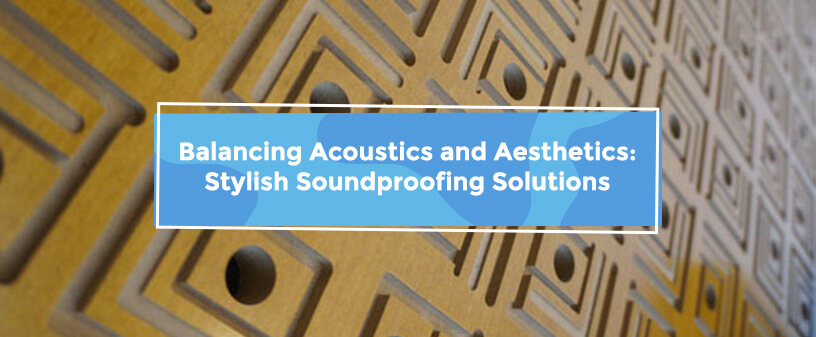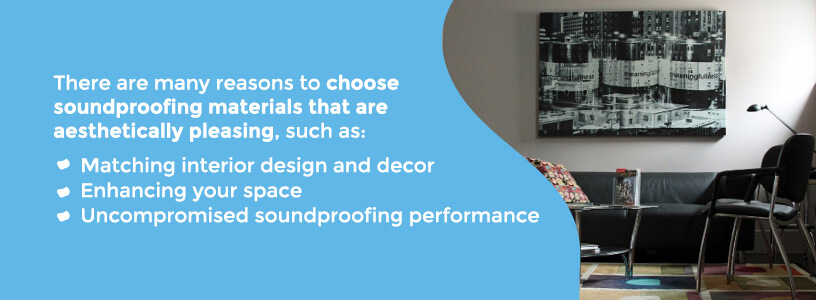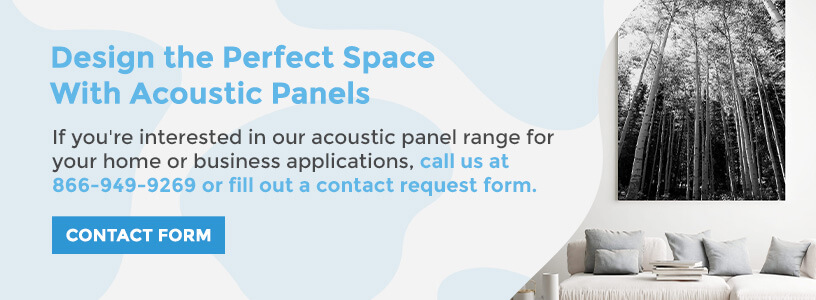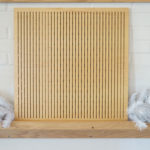
There’s a fine line for finding a balance between aesthetics and acoustics. The benefits of stylish soundproofing solutions go beyond what the eye can see and ears can hear.
Learn more about designing for acoustics and aesthetics, the best aesthetic soundproofing materials, and how Soundproof Cow can help you strike the perfect balance.
Soundproofing a Home Living Area for Comfort, Privacy and Visual Appeal
Soundproofing aims to lessen sounds from outside or within — doing this while maximizing comfort, privacy and visual appeal is a bonus. For example, you may consider converting your garage into an impromptu home theater. Or, if one of your kids needs an isolated study area, you might convert the spare bedroom for this purpose.
Considering other household members is important when deciding on aesthetic soundproofing. You want the area to serve its function while offering comfort, privacy and visual stimulation for the occupants inside.
Commercial Aesthetic Soundproofing Applications
Commercial areas that require soundproofing include meeting rooms, boardrooms, and offices in corporate settings and professional recording studios in the music industry. Other business applications where the aesthetic appeal is as important as ensuring it’s soundproof include:
- Restaurants: Secure, soundproof restaurant spaces allow patrons to enjoy meals in intimate settings.
- Hotels: Hotels may offer guests phone booths and special conference rooms for private meetings.
- Universities: Libraries, computer rooms and study areas in universities benefit from the dual functionality of aesthetic soundproofing.
- Auditoriums: The vast space makes hearing difficult for those in the back, so aesthetic soundproofing is perfect for auditoriums.
Increased comfort and privacy allow occupants to focus on what’s important without any distractions.
Reasons for Choosing Visually Appealing Soundproof Materials
There are many reasons to choose soundproofing materials that are aesthetically pleasing, such as:
- Matching interior design and decor: When your soundproofing material matches the space’s interior design elements, furniture and other decor, everything blends together naturally.
- Enhancing your space: A cohesive color scheme and style enhance a space while providing the necessary soundproofing requirements.
- Uncompromised soundproofing performance: With beauty and functionality, this combination provides users with the best of both worlds. Who wouldn’t enjoy that?

How to Design for Acoustics and Aesthetics
Designing for acoustics and aesthetics creates visual and audio flow and harmony in a space. Traditional soundproofing methods like egg cartons cushioned with mattress lining might be functional, but they can detract from the professionalism or design of a room. Modern alternatives like acoustic panels, foam and fiberglass provide more opportunities to create aesthetically pleasing acoustic accessories.
The surfaces in a room affect the way sound travels. For example, hard surfaces like wood, metal and concrete cause sound to reverberate, while soft surfaces like carpet, acoustic panels and foam tend to soak up sounds. In other words, the more dense a surface is, the more sound bounces off it.
There are a few different types of sound movement and each plays a unique role in the design process:
- Absorption: Sound waves may be absorbed in an object or material instead of reflecting it.
- Reverberation: Reverberation occurs when sound reflects off surfaces to create a vibrating effect after the initial sound has stopped.
- Diffusion: With devices called diffusers, sound can be distributed evenly within an area regardless of where the sound originates.
A balanced sound surface ensures the right resonance is achieved. Avoiding too much echo, loudness and bass is important to achieve coherence. Incorporating soft sound elements in areas filled with hard surfaces could help accomplish the ideal sound effect.
Sound Rating Scales
Your desired soundproofing outcome depends on how sound waves are measured on surfaces. Two rating scales determine surface reflectiveness or receptiveness. The Sound Transmission Class (STC) measures how well sound reflects or reverberates off the surface, while the Noise Reduction Coefficient (NRC) quantifies how much sound energy the surface absorbs.
High NCR ratings ensure materials provide better quality to reflect sound so you can enjoy daily activities without disturbing the neighbors. On the other hand, high STC-rated materials are ideal for busier living spaces like apartments where sound tends to travel through walls instead of reflecting off them.
Combining Acoustic Materials
Using elements of NRC and STC, you can find an appropriate solution to ensure a good acoustic design and aesthetic balance. The trick is in the materials and how well they work together to achieve the desired results.
For example, a room that combines glass walls, perforated ceilings and carpets prevents echoes:
- Glass is a hard surface that reflects sound, and its transparency lends an open feel to rooms that might otherwise feel crowded.
- Perforated ceilings have a special design that absorbs sound so occupants don’t have to raise their voices during conversations.
- Carpets provide an aesthetic focal point to a room and offer cushioning against echoes by absorbing sounds.
As such, the design of a room can be simultaneously attractive and soundproof. Other materials and objects that can enhance an area’s aesthetic and acoustic appeal include:
- Dividers
- Artwork
- Panels
- Curtains
- Furnishings
The Best Aesthetic Soundproofing Materials
Many soundproofing materials are available, but they don’t all provide an aesthetic appeal. Check out these top materials to help you customize and soundproof your home or office space:
Art Acoustic Panels
Convert any area into a life-size art gallery with this exquisite aesthetic soundproofing option. Have an image blown up and printed on sound- and fade-resistant panels. These realistic, high-quality art panels suit various applications, including nurseries, bedrooms, home offices or living rooms. In offices, they can be used in conference rooms, cubicles and booths for increased privacy, or in open-floor plans to reduce echo and sound.
If you’re keen on displaying fresh new art or are bored of the same imagery, you can change things up. ADAPT® Acoustical Treatments allows you to replace images within single frames anytime.
Fabric Wrapped Acoustic Panels
You have free creative reign with the customizable fabric-wrapped Udderly Quiet® Acoustic Panels from Soundproof Cow. The image and fabric choice is yours, allowing you to personalize any space to your taste and design specifications. These panels are perfect for muffling internal and external sounds for increased privacy.
If you need to record or listen to audio, you’ll enjoy complete silence in a room covered in fabric-wrapped acoustic panels. It is also ideal in restaurants, offices, gymnasiums, recording studios and home theaters. Soundproof Cow’s Series range has something to suit everyone’s budget and needs.
Perforated Acoustic Wood Panels
For an elegant, sophisticated aesthetic soundproof finish, you might opt for the perforated acoustic wood panels. Soundproof Cow offers a large selection of patterns, veneers and finishes to choose from, with applications ranging from restaurants, offices and hotel lobbies to churches, classrooms and auditoriums.
Design the Perfect Space With Acoustic Panels From Soundproof Cow
At Soundproof Cow, we moove mountains to provide our clients with the best products and services. Our free acoustic analysis offers you peace of mind before committing and our soundproofing products are backed by our No Bull promise.
If you’re interested in our acoustic panel range for your home or business applications, call us at 866-949-9269 or fill out a contact request form with your details.









